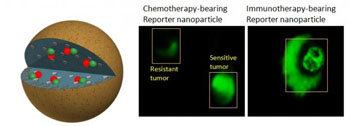Bifunctional Anticancer Nanoparticles Deliver a Drug and Then Report Whether It Works
By LabMedica International staff writers
Posted on 11 Apr 2016
A novel nanoparticle-based transport system not only delivers an anticancer agent to a tumor, it reports whether the treatment is working.Posted on 11 Apr 2016
The ability to monitor the efficacy of an anticancer treatment in real time can have a critical effect on the patient's outcome. Currently, determination of a treatment's effectiveness relies on indirect or anatomic measurements, which occur over prolonged time scales and follow chemotherapy, radiotherapy, or immunotherapy and may not accurately reflect the actual effect.

Image: Using reporter nanoparticles loaded with either a chemotherapy or immunotherapy, researchers could distinguish between drug-sensitive and drug-resistant tumors in a pre-clinical model of prostate cancer (Photo courtesy of Dr. Ashish Kulkarni, Brigham and Women\'s Hospital).
Investigators at Brigham and Women's Hospital (Boston, MA, USA) recently described a new approach for evaluating the effectiveness of cancer treatment early in the therapeutic effort.
Their method utilizes bifunctional nanoparticles that delivered both an anticancer agent and a fluorescent reporter mechanism to the tumor. The reporter system was based on the activation of the enzyme caspase that occurred when cancer cells began to die. Caspase that was released when the transported drug was successful caused the reporter molecule to emit green fluorescence, which was detected easily with a microscope.
Using chemotherapy-sensitive and chemotherapy-resistant tumors in vivo, the investigators showed that the reporter nanoparticles could provide a real-time noninvasive readout of tumor response to chemotherapy.
They reported in the March 29, 2016, online edition of the journal Proceedings of the National Academy of Sciences of the United States of America (PNAS) that in a preclinical model of prostate cancer, nanoparticles loaded with the anticancer drug paclitaxel caused a 400% increase in fluorescence in sensitive cells compared to cells in tumors that were not sensitive to the drug. The increase in fluorescence was apparent about eight hours after beginning the treatment.
In an immunotherapy approach that employed nanoparticles to target PD-L1 (Programmed cell death protein ligand 1) in a preclinical model of melanoma, the investigators found a significant increase in the fluorescent signal after five days.
"Using this approach, the cells light up the moment a cancer drug starts working. We can determine if a cancer therapy is effective within hours of treatment," said senior author Dr. Shiladitya Sengupta, assistant professor of health sciences and technology at Brigham and Women's Hospital. "Our long-term goal is to find a way to monitor outcomes very early so that we do not give a chemotherapy drug to patients who are not responding to it."
Related Links:
Brigham and Women's Hospital




 assay.jpg)







